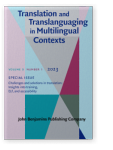Book review
Susan Petrilli & Meng Ji (eds.). Exploring the Translatability of Emotions: Cross-Cultural and Transdisciplinary Encounters. Cham: Palgrave Macmillan, 2022. 409 pp. ISBN 9783030917470
References (13)
References
Damasio, Antonio. 1994. Descartes’ Error: Emotion, Reason, and the Human Brain. New York: Putnam.
Damasio, Antonio. 2018. The Strange Order of Things: Life, Feeling, and the Making of Cultures. New York: Pantheon.
Hermans, Theo. 2019. “Untranslatability, Entanglement and Understanding.” In Untranslatability: Interdisciplinary Perspectives, ed. by Duncan Large, Motoko Akashi, Wanda Józwikowska, and Emily Rose, 27–40. New York: Routledge.
Hubscher-Davidson, Séverine. 2018. Translation and Emotion: A Psychological Perspective. New York: Routledge.
Hubscher-Davidson, Séverine, and Caroline Lehr. 2021. Improving the Emotional Intelligence of Translators. London: Palgrave MacMillan. 

Jakobson, Roman. 1959. “On Linguistic Aspects of Translation.” In On Translation, ed. by Reuben Arthur Brower, 232–239. Cambridge: Harvard University Press.
Kahneman, Daniel. 2011. Thinking, Fast and Slow. New York: Farrar, Straus and Giroux.
Marais, Kobus. 2019. A (Bio)Semiotic Theory of Translation. London: Routledge.
Nida, Eugene A. 1964. Toward a Science of Translating with Special Reference to Principles and Procedures Involved in Bible Translating. Leiden: E.J. Brill.
Perniola, Mario. 1991. Del sentire. Turin: Einaudi.
Petrilli, Susan. 2015. Victoria Welby and the Science of Signs. New York: Routledge.
Petrilli, Susan, and Meng Ji, eds. 2022. Intersemiotic Perspectives on Emotions: Translating across Signs, Bodies and Values. London: Routledge. 

Thaler, Richard, and Cass Sustein. 2009. Nudge: Improving Decisions about Health, Wealth, and Happiness. London: Penguin.
